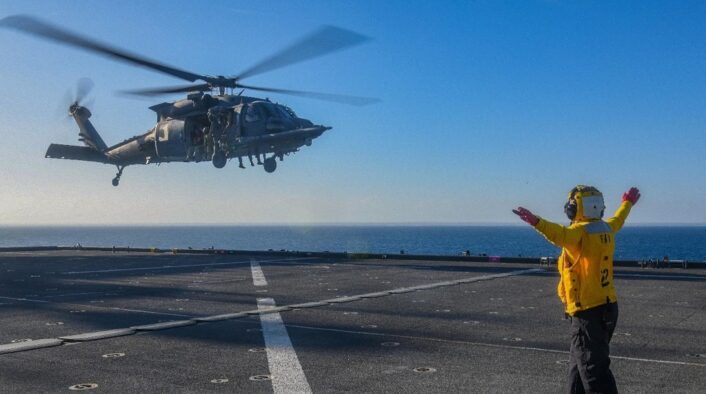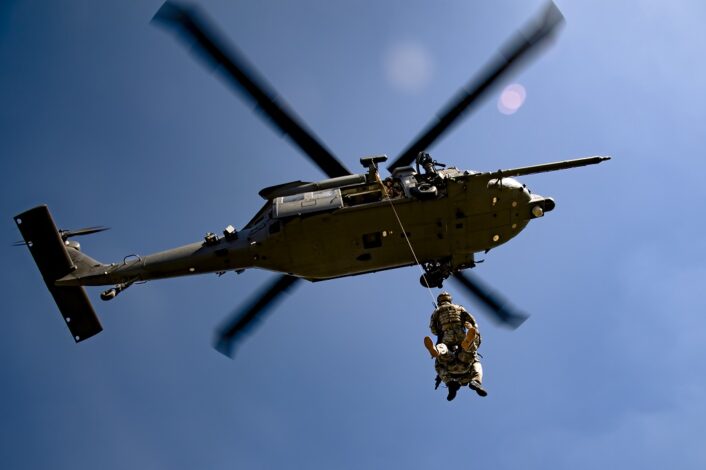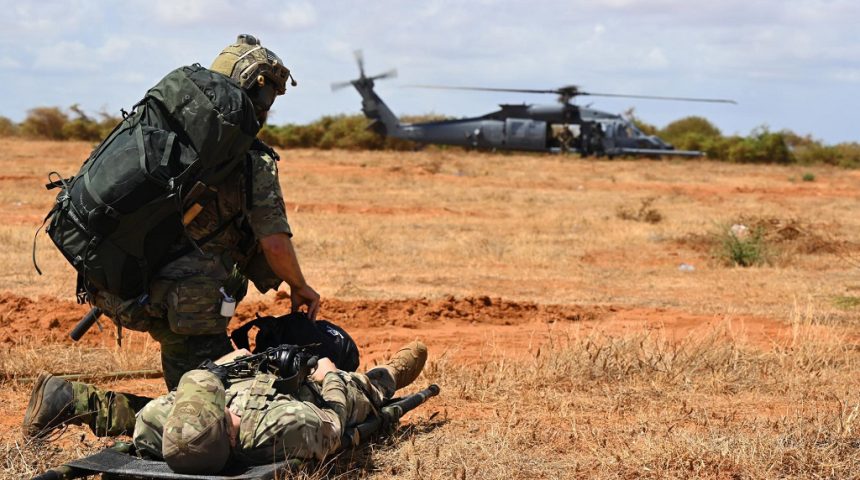The Jolly Green II was quietly deployed to the Horn of Africa immediately after reaching the Initial Operational Capability.
Back in September 2022, the newest U.S. Air Force combat rescue helicopter, the HH-60W Jolly Green II, reached the IOC (Initial Operational Capability) and was immediately sent out on the type’s first-ever operational deployment. At the time, the Air Force did not provide details about the deployment, however the service has now acknowledged that the helicopter is in the African AOR (Area Of Responsibility) and recently performed the first combat CASEVAC (CASualty EVACuation), saving two lives.
The press release did not mention where the mission took place, simply stating that it happened outside the wire in an undisclosed location in the Horn of Africa. The mission involved a combined force of HC-130J Combat King II recovery aircraft and Guardian Angels from the 347th Rescue Group, as well as HH-60W combat rescue helicopters assigned to the Personnel Recovery Task Force (PRTF), under the direction of the 449th Air Expeditionary Group and the Joint Personnel Recovery Center (JPRC). The 449th AEG is stationed at Camp Lemonnier, Djibouti, which usually hosted HH-60G Pave Hawk helicopters.

“The PRTF is specifically manned, trained, and equipped to rapidly respond to emergency battlefield situations to return American, allied and partner forces to friendly control,” said Lt. Col. Thaddeus Ronnau, commander of the PRTF and regional director of the JPRC at Combined Joint Task Force-Horn of Africa. “While personnel may be behind enemy lines, or far from needed support, this team is equipped to travel great distances and fight their way in and out if necessary to make the mission happen.”
According to the press release, alert crews were activated during the pre-dawn hours and responded quicker than the required theater response times. The initial pick up of the injured was quick, and the team was in and out of the area without incident. They then immediately made for the nearest medical facility for trauma surgery while the Pararescuemen performed their own stabilizing emergency medical care in the aircraft’s cabin. The HC-130Js were then called to swiftly move the most seriously wounded member to another location for further treatment. Both lives were saved.
“Even in the vast expanses of Africa, this combined team was able to pull a critical patient from the battlefield with the Air Force’s newest Rescue vehicle and place them in the hands of skilled trauma surgeons, ultimately saving two lives,” Lt. Col. Ronnau said. “By continuously working to ensure that ‘Jack’s worst day won’t be his last,’ these members of the Rescue family upheld the highest virtues of the Code of the Air Rescueman and demonstrated ‘these things we do that others may live.’”
So far, the first operational deployment of the HH-60W Jolly Green II was kept under wraps, without info or media released. In December, however, some photos appeared on the DVIDS (Defense Visual Information Distribution Service) network in two different occasions. The photos were not accompanied by press releases, so the only few details were found in the captions.
At the beginning of the month, the photos depicted the HH-60W during a CASEVAC exercise, confirming for the first time that the helicopter was deployed to the Combined Joint Task Force-Horn of Africa area of responsibility. While the photos’ captions only mentioned an undisclosed location in Djibouti, the tags included Camp Lemonnier, which as already mentioned, might be the location where the helicopters are deployed, since it already hosted HH-60G helicopters.
Few weeks later, new photos showed the HH-60W operating on the flight deck of the Lewis B. Puller-class expeditionary sea base USS Hershel “Woody” Williams (ESB 4), which is on a scheduled deployment in the U.S. Naval Forces Africa area of operations and part of the U.S. Sixth Fleet. The caption did not provide new info, as the involvement of the 41st Rescue Squadron in the deployment was already known.
In fact, a press release from November mentioned that the unit underwent extensive training in preparation for the first deployment of the HH-60W, expending more hoist cables than anticipated and leading to a potential shortfall. The ingenuity of the 41st Rescue Generation Squadron’s Airmen helped to quickly find a solution by converting the HH-60G cables for use in the HH-60W. The process ensured the safe use of the hoist cables by synchronizing the speed in which they extend at the appropriate points of the cable and was quickly safe checked and approved by the engineers from Warner Robins Air Force Base, ensuring the HH-60W was fully mission-capable and ready to deploy.










